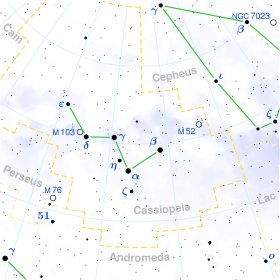Andromedids
| Andromedids | |
|---|---|

| |
| Parent body | 3D/Biela |
| Radiant | |
| Constellation | Andromeda |
| Right ascension | 01h 36m[2] |
| Declination | +37°[2] |
| Properties | |
| Occurs during | September 25 – December 6[3] |
| Date of peak | November 9[2] |
| Velocity | 19[2] km/s |
| Zenithal hourly rate | 3[2] |
The Andromedids meteor shower is associated with Biela's Comet, the showers occurring as Earth passes through old streams left by the comet's tail. The comet was observed to have broken up by 1846; further drift of the pieces by 1852 suggested the moment of breakup was in either 1842 or early 1843, when the comet was near Jupiter.[4][5] The breakup led to particularly spectacular showers in subsequent cycles (particularly in 1872 and 1885).[3][6]
In the early 19th century, before the break-up of comet 3D/Biela, the radiant was in Cassiopeia.[7] In the last century the radiant of the modern weaker meteor shower is generally in the constellation of Andromeda as the name of the shower suggests, but due to its age and diffuseness meteors may appear to come from the neighbouring constellations, such as Pisces, Triangulum and Cassiopeia.[2][4]
Historical appearances
The first known sighting of the Andromedids was December 6, 1741, over St Petersburg, Russia.[6] Further strong showers were witnessed in 1798, 1825, 1830, 1838 and 1847. The Andromedids produced spectacular displays of several thousand meteors per hour in 1872 and 1885, as a result of Earth crossing the comet's debris stream. In Burma, the 1885 shower was perceived as a fateful omen and was indeed followed swiftly by the collapse of the Konbaung dynasty and the conquest by Britain.[8]
The November 27, 1885, shower was the occasion of the first known photograph of a meteor, taken by Austro-Hungarian astronomer, Ladislaus Weinek, who caught a 7mm-long trail on a plate at his Prague observing station.[9]
Current activity
Since the 19th century the Andromedids have faded so substantially that they are no longer generally visible to the naked eye, though some activity is still observable each year in mid-November given suitable detection equipment.[6] In recent years, peak activity had been less than three meteors per hour, around November 9[2] to 14.[3] Andromedid activity of November comes from the newest streams, while that of early December comes from the oldest.[3]
On December 4, 2011, six Canadian radar stations detected 50 meteors in an hour. The activity was likely from the 1649 stream.[7] On December 8, 2013, Meteor specialist Peter Brown reported that the Canadian Meteor Orbit Radar had recorded an outburst from the Andromedid meteors in the past 24 hours.[1] Scientists postulate a somewhat weaker return in 2018, but a yield of up to 200 meteors an hour in 2023.[7][10] Canadian Meteor Orbit Radar (CMOR) data also detected a spike of 30 meteors per hour on November 27, 2008.[7]
During the 2012 shower an inconspicuous maximum occurred on November 9.[2]
References
- 1 2 Kelly Beatty (8 December 2013). "An Outburst of Andromedid Meteors". Sky & Telescope. Retrieved 2013-12-09.
- 1 2 3 4 5 6 7 8 "Meteor Activity Outlook for November 17-23, 2012". International Meteor Organization (IMO). Retrieved 2012-12-11.
- 1 2 3 4 Gary W. Kronk. "Observing the Andromedids". Meteor Showers Online. Retrieved 2011-04-18.
- 1 2 Peter Jenniskens (3 April 2008). "The Mother of All Meteor Storms". Space.com. Retrieved 2011-04-18.
- ↑ Jenniskens, Peter; Vaubaillon, J. R. M. (2007). "3D/Biela and the Andromedids: Fragmenting versus Sublimating Comets". Astronomical Journal. 134 (3): 1037–1045. Bibcode:2007AJ....134.1037J. doi:10.1086/519074.
- 1 2 3 Carl W. Hergenrother. "The Meteor Storms of November – Part I – The Andromedids". The Transient Sky Blog. Retrieved 2011-04-18.
- 1 2 3 4 Paul A. Wiegert; Peter G. Brown; Robert J. Weryk; Daniel K. Wong (26 Sep 2012). "The return of the Andromedids meteor shower". Astronomical Journal. arXiv:1209.5980
 . Bibcode:2013AJ....145...70W. doi:10.1088/0004-6256/145/3/70.
. Bibcode:2013AJ....145...70W. doi:10.1088/0004-6256/145/3/70. - ↑ Lonely Planet Myanmar, 10th edition page 256
- ↑ Hughes, Stefan (2012). Catchers of the Light: The Astrophotographers' Family History. Catchers of the Light . p. 457. ISBN 162050961X. External link in
|publisher=(help) - ↑ Croswell, Ken. "The Return of a Great 19th-Century Meteor Shower". Scientific American. Retrieved 19 October 2012.
External links
- History of the Andromedids and of the Biela Comet (Gary W. Kronk)
- The Mother of All Meteor Storms (Space.com April 2008)